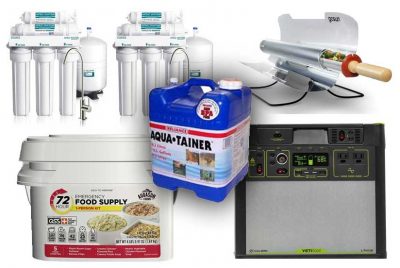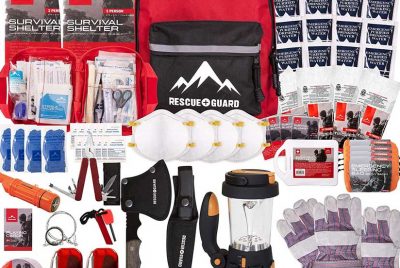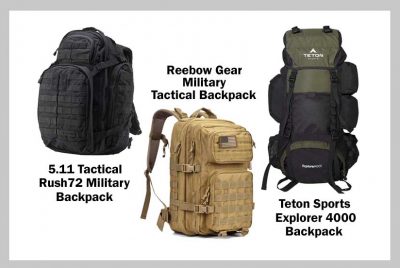There are lots of cheap prepper supplies that are great for building a beginner's survival kit.…
30 Must-Have Survival Supplies for an Emergency

An emergency or disaster can happen without notice. And when an earthquake, wildfire, or hurricane does occur, you and your family will have a better chance of thriving during this difficult time if you’ve already got your survival supplies packed and ready to go. Buying a pre-made survival kit that includes essential survival supplies is certainly the easiest option. However, since everyone has different needs, they won’t have everything you’ll want in your emergency kit.
Where to Find Survival Supplies for Your Survival Kit
You have three choices for building a kit that will include the survival supplies that are most important to you. First, you can buy a ready-made kit that has already been stocked with the most essential items. Second, you can buy a kit and then add any additional items that you will need to that kit. And third, you can compile everything you need from scratch. In my opinion, buying a ready-made pack is not the best approach. Certainly, buying a ready-to-go survival bag is better than having nothing. But the best option is to build a kit from scratch that will include everything you need for your personal situation.
Below you’ll find a fairly extensive list of items that most individuals will want to pack for emergencies. There are a lot of items in the list, and all are not absolutely necessary for you to include in your survival pack. If you’re preparing for an emergency, you should go through the list and choose the items that you feel would be most important for you and your family.
The items listed below are assuming you’ll have access to a vehicle. If you have to leave your vehicle behind and travel away from home on foot, you will not be able to carry everything in a single backpack. It is wise to have a bug out bag or survival backpack loaded with the most important survival items for each member of your family. But it’s also a good idea to have a much larger kit that contains your bug out bags as well as other items you would like. That way, you will be ready to grab your backpacks and head out on foot if you don’t have access to a vehicle. And if you did have access to a vehicle, you would be able to quickly pack your vehicle with the bug out bags, as well as the other essential survival supplies in your kit. Either way, you’ll be prepared to grab the essentials and head out the door at the drop of a hat.
Planning for an Emergency Comes First
Most survivalists will put water at the top of their survival list. However, even before water, you need a plan. What happens if an emergency occurs when you’re at work, your spouse is at home, and your kids are in school? Develop a simple communication plan with your family. Everyone will need to know where to meet and who to call (preferably, someone who is out of state) if the power goes out. Also, keeping all of your survival gear in one or two large containers will make it easier to grab and carry out to your car or truck.
1. Water – the Number One Item for Survival
The most important item on any survival checklist is water. You can live without a lot of things, but you can’t live very long without water. An average adult will need about one gallon of water per day. Half of this would be used for drinking and half for washing or cleaning. Having water bottles as well as heavy duty water storage containers is ideal. You may have an emergency where you will be able to stay in your home, in which case large water containers would be very handy if your water was shut off.
2. Water Filter or Water Filtration System
If you’re forced from your home for more than just a few days, you will eventually run out of water. In this case you’ll want to have some type of water filter or water filtration system to produce more clean drinking water. When you’ve finished drinking water from your water bottles, be sure to save those empty bottles. They can be refilled once you’ve filtered more water. At the very least take along some water purification tablets. They are small in size and easily fit in a backpack. But it’s also a good idea to pack some type of water filter. Depending on the number in your party, you’ll want to bring water filter bottles, pump filters, or gravity filters.
3. Survival Food Supply
Next to clean drinking water, a survival food supply is the next most important item you’ll want to have on hand. Packing energy bars or granola bars is a great food source and high in calories. These don’t take up much room in a survival kit and they’re lightweight as well. Additionally, you’ll want to bring along some freeze-dried or dehydrated food. They can either be purchased from an emergency food supply company or you can make them yourself.
4. Survival Clothing
Depending on where you live and what time of year it is, you will want to pack the appropriate clothing. Your clothing will vary depending on whether you’re in an extremely hot climate or extremely cold climate. Items like hats, ponchos, gloves, and umbrellas will offer protection from the sun, rain, or snow. Having comfortable walking shoes is also a must.
5. Survival Shelter and Bedding
A tarp can be setup to protect against inclement weather. Plastic sheeting can be placed on the ground under your tarp to keep your sleeping bag dry. And blankets can also provide extra warmth. If you’re on foot, a space blanket may be your best bet. They’re extremely lightweight and don’t take up much room.
6. Rope has Many Uses in a Survival Kit
There are many uses for a rope. It can be used to hang up a tarp to protect you against the sun, rain, or snow. Other uses include tying items to your backpack, hanging food up high in a tree to prevent animals from getting to it, and even rappelling down a mountain.
7. Survival Knife – Vital Survival Gear
A good strong survival knife is another versatile item that you almost can’t live without. It can be used for food preparation, making kindling, cutting rope, and even protection from other survivalists. Check out these 8 survival knives.
8. Strong, Durable Axe – A Useful Survival Tool
An axe can be useful for chopping wood for the fire or as a substitute for a hammer, as well as for self defense.
9. Emergency Radio
Another good item to have on hand is an emergency radio with good reception. It should have the ability to be recharged with a hand crank or with portable solar power. A good radio will give you advanced weather alert warnings. Many also have built-in flashlights. With some models, all it takes is a minute of hand cranking to produce as much as 30 minutes of flashlight time and 45 minutes of radio time.
10. Cell Phone, Charger, and Backup Solar Power
A cell phone can keep you in contact with the world. But once the battery runs down you’ll need a way to charge it back up. That’s where a portable solar power pack comes in. As long as there’s some sunshine you can keep all of your important electronics charged up. This is especially useful for mobile phones and emergency radios.
11. First Aid Kit and Medications
The first aid kit doesn’t need to be extensive, but bringing band-aids, gauze, tape, and antiseptic spray is a good idea. Also, some medications may come in handy, such as pain relievers, laxatives, antacids, or anti-diarrhea medication. In addition, if someone in your party is taking prescription medication, be sure to bring that along as well.
12. Survival Safety Whistle
Most people wouldn’t think of a whistle as a necessary survival supply. But if you’re lost or need medical help, or you have a mobile phone but no reception, a whistle can be just what you need to alert others in the area of your trouble.
13. Protection from Other Survivalists
If you find yourself all alone after a disaster, chances are there will be other people in the same situation. And if you run into another survivalist who will do anything to survive, including hurting you to get what they want, you’ll want to have some way to protect yourself. That protection could be the knife or axe you’ve already stashed in your survival backpack or bug out bag. But it could also be one of many other items. You may want to consider packing a self-defense baton, self-defense keychain, stun gun, or mace, as protection. Be sure to check your local laws before buying a weapon to make sure you’re not breaking the law.
14. Dust Masks or Gas Masks Can be Very Beneficial in a Survival Kit
With a chemical spill or wildfire the air can become extremely unhealthy. A face mask or respiratory mask can filter the poisonous air, making it safe for you to breathe. Face masks or dust masks can filter out debris, but a gas mask or respiratory mask can filter poisonous air much more efficiently. If you’ve got enough room in your pack of survival supplies for a gas mask, it’s the best choice. But even a face mask can improve the air you breathe.
15. Flashlight
When you find yourself in the middle of nowhere, in the dark, you’ll be glad you packed a reliable tactical flashlight and some extra batteries. You can also pack a headlamp or backup emergency candle, but a flashlight should be your number one choice. To save room in your survival pack you can bring along an emergency radio that doubles as a flashlight. And if it’s a hand-cranked emergency radio, you may not even need to bring extra batteries.
Like this Article? Pin it on Pinterest

16. Waterproof Matches and Fire Starter
Having the ability to light a fire is very important. Waterproof matches, a lighter, or a fire starter of some kind will make it possible to stay warm, cook your food, or boil water to sanitize things.
17. Local Map and Compass
If you’re forced to quickly evacuate your home on foot, having a local map and a compass can help you to know where you are. It’s easy to get lost, so having a map and compass at your disposal during a disaster or emergency evacuation is a smart option.
18. Portable Camp Toilets
When you’re forced to evacuate your home, it’s only a matter of time before you’ll need to take care of business. When that time comes, it’s best to have a portable camp toilet. Portable toilets come in many sizes, from a simple 5-gallon bucket with a seat to a luxury toilet that’s almost like home. If you’re going to be on the move a lot, it’s best to have a lightweight, easy-to-carry toilet. But if you’re evacuating in your vehicle (no pun intended), and looking for a temporary place to ride out the emergency, a luxury portable camp toilet might be the most convenient.
19. Infant Survival Supplies
If you’ve got a baby, you will certainly want to add a few baby items to your emergency survival kit. Things like infant formula, diapers, bottles, baby wipes, and even diaper rash cream. Having to deal with an uncomfortable baby during a survival situation will not have a calming effect on your party. The baby wipes can be packed even if you don’t have a baby. Baby wipes or moist hand wipes can be very useful for many things.
20. Cash
When it comes to emergency survival situations, cash is king. Most often you’ll find yourself in an area where there will be other people around. And if you find you need something that you forgot to pack, or couldn’t fit into your bag of survival supplies, some cash may get you what you need.
21. Garbage Bags
Trash bags and plastic ties are good items to have for personal sanitation. Even in an emergency situation it’s always a good idea to keep things cleaned up. This is especially true when it comes to portable camp toilets. It’s important to dispose of any waste products or food scraps in a sanitary way. Otherwise, those items could attract unwanted predators, or at the very least, smell really bad.
22. Manual Can Opener
If you’re packing canned foods, how do you plan on opening them? Without a manual can opener you may find yourself jabbing a knife blade or axe into the can. Dulling or breaking your knife blade could be the end result. A can opener takes up very little space, so it’s always a good idea to have one handy.
23. Pliers or Wrench and Fire Extinguisher
What if there’s an earthquake that ruptures a water pipe or gas pipe on your property? A wrench or pair of pliers can give you the ability in many situations to turn off utilities that might otherwise create a dangerous situation. Some disasters can result in fires in and around your home, which is where a fire extinguisher could be beneficial.
24. Dog Survival Basics
If you’ve got a dog you will most likely want to take it with you. After all, leaving man’s best friend behind is not something most people are willing to do. But this also means packing some specific survival supplies for the dog. Some suggested items are extra water, a dog saddle bag or backpack, dog blanket, food and water bowls, freeze-dried dog food, dog medicine, and doggy treats. Other items, such as water filtration tablets, should already be in your kit, so just make sure there’s enough for both you and the dog.
25. Family Documents
If the emergency happens to be your house burning down, it is a good idea to have your important family documents ready to go too. These will include personal identification, insurance policies, and bank account records, which can also be saved electronically.
26. Duct Tape
So how will duct tape help you in a survival situation? There are too many ways to count. How about to repair a tent, make a clothesline, make a rope, reseal food packages, wrap a sprained ankle, make a sling, repair torn clothing, and the list goes on and on.
27. Feminine Supplies and Personal Hygiene Products
Feminine products like sanitary napkins, and personal hygiene products such as soap, toothpaste, and toothbrush are all good items to add to your bug out bag.
28. Paper Plates, Paper Cups, Utensils, and Paper Towels
You’ve got all the freeze-dried food you can eat, but how are you going to eat it? Disposable paper plates, cups, towels, and plastic utensils are ideal for emergencies and disasters. They are light and take up a small amount of space, making them better than their real and heavy counterparts. You can also use mess kits, which are just as good, but require cleaning after every meal.
29. Paper and Pencil
Bringing along a paper and pencil is also a good idea. If you ever need to make a note of something, or write your location on a map, paper and pencil is the way to go. They can also be used for games to pass the time.
30. Books, Puzzles, and Games
And speaking of passing the time, books, puzzles, or games can be great things to pack as well, especially if you have children in your party. It can get awfully boring if you’re waiting out the emergency in one, solitary location.
Wrapping Things Up
If you’re storing canned food, keep it in a cool, dry place. Also, it’s a good idea to store any boxed meals in tightly closed containers. Some foods will only store well for a specific period of time. Be sure to replace those foods periodically so you’ll have fresh, nutritious food if needed. And remember to look over your survival supplies every once in awhile and update your survival kit when called for. For example, if your baby gets old enough to stop using diapers or a baby bottle, it’s no longer necessary to keep those in your kit.
Always have your emergency supplies in a place that’s easy to get to. You need to be able to grab them and go at a moment’s notice when the situation calls for it. It’s also smart to have survival supplies at home, at work, and even in your car. Then, no matter where you are, when disaster strikes, you’ll be ready.



